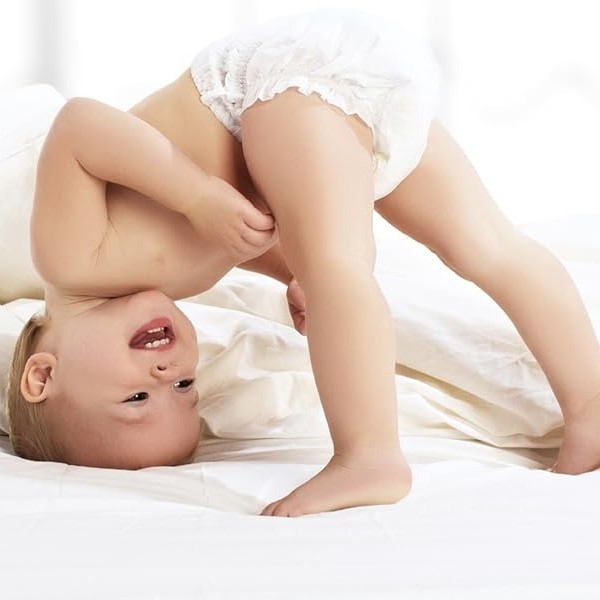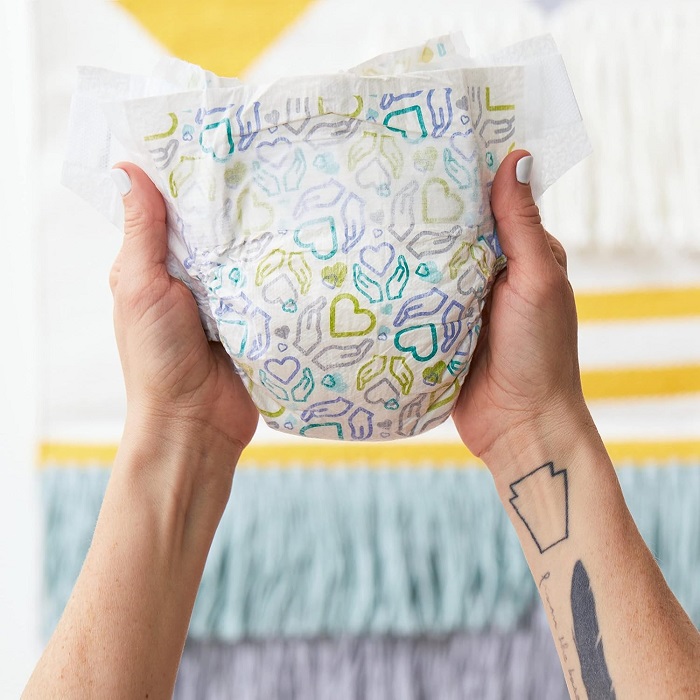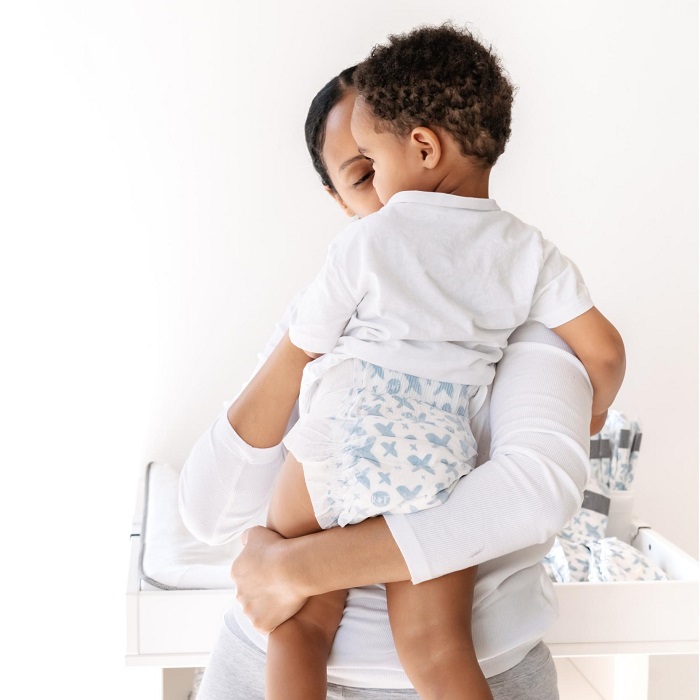Understanding Diaper Sizes
Choosing the right diaper size is crucial for your baby’s comfort and to avoid leaks. Here’s what you need to know about diaper sizes:
- Check the weight range: Diaper brands provide a weight range on the packaging. Relate this to your baby’s current weight to find the best fit.
- Age as a guideline: Age can be a general guide, but it’s less accurate than weight, since babies grow at different rates.
- Look for size indicators: Most brands have a size indicator on the diaper itself, which can help you know when it’s time to move up a size.
- Preemie to larger sizes: Diapers come in sizes from preemie to 6 or higher for larger toddlers. As your baby grows, you’ll need to move up in diaper size.
- Special sizes for different needs: Some brands offer extra small or extra large sizes, and even size variations for different body types.
Remember, a snug fit is what you aim for. Diapers should fit comfortably around the waist and thighs without being too tight or too loose. If the diaper leaves marks on your baby’s skin or if there are frequent blowouts or leaks, it may be time to try a different size. Learning how should diapers fit your baby will save you from many messy situations.
Key Indicators of a Good Diaper Fit
Achieving the ideal fit for diapers can significantly enhance a baby’s comfort and prevent common issues such as leaks and rashes. Here are the critical indicators that you should look for to ensure a good diaper fit for your baby:
- Snug waist: The diaper should wrap well around your baby’s waist. There should be enough room to slide two fingers under the waistband, but it should not be too loose.
- Secure tabs: Diaper tabs must stick firmly on the front without being overly stretched. If the tabs pull off easily or need to be overly stretched, the size may not be correct.
- Gentle leg cuffs: Check that the leg cuffs wrap gently around your baby’s legs without leaving marks. There should be no gaps where leaks could occur.
- No red marks: After removing the diaper, there should not be any red marks on your baby’s skin, which can indicate that the diaper is too tight.
- Even distribution: Make sure the absorbent area of the diaper is even and straight. It should not sag or bunch up.
- The ‘right’ weight: Always refer back to the weight range suggested by the diaper brand. This is one of the most reliable indicators of the proper size.
Remember, observing how diapers fit your baby is vital. Pay close attention to the above indicators to help maintain your baby’s comfort and health.
Common Fit Problems and Solutions

Managing diaper fit problems is part of parenting a baby. Here are some issues and how to solve them:
- Leaking diapers: This often means the diaper is too small. Try a larger size to ensure better coverage.
- Gaps around legs: If there are gaps, the diaper may be too big or not properly fitted. Adjust the diaper’s tabs and leg cuffs for a snugger fit.
- Diaper rash: This can be a sign of infrequent changing or a too-tight fit. Change diapers more often and make sure the diaper isn’t snug on the baby’s skin.
- Blowouts up the back: Consider going up a size for more absorbency, or try a different brand with a better fit around the waist.
- Red marks on skin: If the diaper leaves red marks, it may be too tight. Look for a larger size or a brand with softer elastic.
- Diaper sagging: If the diaper sags, it might be too large or it’s time for a change. Ensure you’re using the correct size and check for frequent changes.
By knowing ‘how should diapers fit’, you can address these common problems. Always look for signs that the fit is not correct and adjust as needed. Regular fit checks ensure that your baby stays comfortable and prevents most issues.
Tips for Diaper Fitting for Newborns
Fitting diapers on newborns is distinct from older infants. Here’s what to keep in mind:
- Gentle Snugging: Ensure the diaper fits your newborn gently without tightness.
- Umbilical Cord Cut-out: Choose diapers with a cut-out design to protect the healing umbilical stump.
- Frequent Checks: Newborns soil diapers often. Check and change diapers every two to three hours.
- Adjustable Tabs: Use diapers with adjustable tabs for a customizable fit as your newborn grows.
- Consider Diaper Type: Use disposable diapers designed for newborns or consider cloth diapers that can be resized.
- Weight Guide: Always refer to the weight guide on the diaper package for the best size recommendation.
- Avoid Bulk: Too much bulk can cause discomfort. Look for diapers with a trim fit appropriate for newborns.
- Watch for Leaks: Regularly checked diapers help you identify the right fit and prevent leaks.
- Sensitive Skin Options: Pick brands that offer sensitive skin diapers to prevent rashes.
By knowing ‘how should diapers fit’ your newborn, you can ensure comfort and avoid many typical diapering issues.
Adjusting Diaper Fit as Your Baby Grows

As your baby grows, their diaper fit needs change. This can lead to fit issues if not addressed. Here’s how to adjust the diaper fit throughout your baby’s growth stages:
- Monitor baby’s weight: Regularly track your baby’s weight gain. This will help decide when to move up a size.
- Check for size indicators: Diapers often have lines or patterns that fade when it’s time to size up. Pay attention to these.
- Flexibility is key: Choose diapers with stretchy sides. They can expand for a growing baby’s changing shape.
- Adjust tab placement: As your baby grows, you may need to fasten the tabs in different positions for a snug fit.
- Look for signs of tightness: Red marks or rashes mean the diaper might be too small. It’s time to try a larger size.
- Consider baby’s mobility: Crawling and walking change how diapers fit. You might need a style that’s more secure for active babies.
- Reassess often: Growth can happen in spurts. Regularly assess how the diapers fit and be ready to adjust as needed.
In essence, ‘how should diapers fit’ as your baby grows? They should always be comfortable, secure, and leak-free. Keep a close watch on the fit and upgrade sizes or adjust positions as your baby’s size and activity levels evolve.
Selecting the Right Diaper Brand and Style
Selecting the right diaper brand and style is crucial for a good fit. Not all brands or styles will fit the same, and some may work better for your baby’s specific shape and size. Here are some points to consider when choosing a diaper:
- Brand Reputation: Look for brands known for quality and comfort. Some brands may cater to specific needs like eco-friendliness or sensitive skin.
- Absorbency Levels: Diapers come with different absorbency levels. Daytime diapers might be lighter while overnight diapers offer more protection.
- Special Features: Some diapers have wetness indicators, stretchable sides, or are fragrance-free. Decide which features matter most to you.
- Fit for Movement: If your baby is active, look for diapers designed to stay in place during movement.
- Type of Diaper: Decide between cloth and disposable diapers. Cloth diapers can be more adjustable, while disposables are convenient.
- Size Ranges: Each brand has its own sizing chart. Compare it with your baby’s weight to find the best match.
- User Reviews: Read reviews from other parents. They can give insights on fit and comfort that you may not find on packaging.
Remember, a diaper that fits well enhances your baby’s comfort and helps avoid leaks and rashes. ‘How should diapers fit’ your baby? It is not just about size but also about choosing a brand and style that suits your baby’s needs and lifestyle. Keep these points in mind, and with a bit of trial and error, you’ll find the perfect choice.
The Importance of Regular Size Checks
Ensuring the right diaper fit is an ongoing process. As babies grow quickly and their body shapes change, regular size checks are essential. Here are key reasons why you must conduct these checks frequently:
- Prevent discomfort: A too-tight diaper can cause chafing and discomfort for your baby. Frequent size checks can help avoid this.
- Avoid leaks: Diapers that are too small or too large can lead to leaks. Checking the size helps maintain a leak-free experience.
- Promote healthy skin: The correct size reduces the risk of diaper rash and promotes better skin health.
- Ensure proper absorbency: Regular checks ensure that your baby has the right level of absorbency as they grow.
- Save money: By avoiding the use of improperly fitting diapers, you can prevent wastage and save money.
By asking ‘how should diapers fit’, you remind yourself to assess the size regularly. Make size checks a part of your routine, especially after growth spurts or developmental milestones. This way, you’ll always know when it’s time to move up a size or adjust the fit.
Troubleshooting Leak Issues

Dealing with diaper leaks can be frustrating for any parent. To address this problem effectively and reduce the occurrence of leaks, it’s important to understand the common causes and solutions. Here’s how to troubleshoot leak issues:
- Check the size: If a diaper is too small, it won’t cover your baby properly. Ensure the diaper fits snugly around the waist and thighs.
- Examine the tabs: Make sure the tabs are fastened securely and the diaper is straight. Uneven fastening can lead to gaps and leaks.
- Assess absorbency needs: Some babies require more absorbent diapers, especially at night. If leaks are frequent, consider switching to a higher absorbency.
- Ensure proper application: When putting on the diaper, make sure it’s not too loose or too high. It should sit just below the belly button.
- Look at diaper style: Different babies have different body shapes. Try various styles to find the best fit for your baby.
- Review frequency of changes: Sometimes, leaks occur simply because the diaper is full. Change diapers more often to prevent overflow.
- Consider overnight diapers: For nighttime, consider using diapers specifically designed for extended wear to prevent leaks and ensure a good night’s sleep.
It’s essential to remember that finding the right solution might require some trial and error. By continually asking yourself ‘how should diapers fit’, you’ll become more attuned to your baby’s needs and better equipped to stop leaks before they happen.



